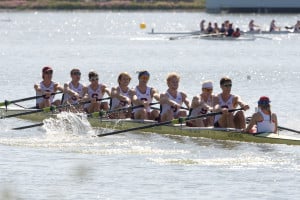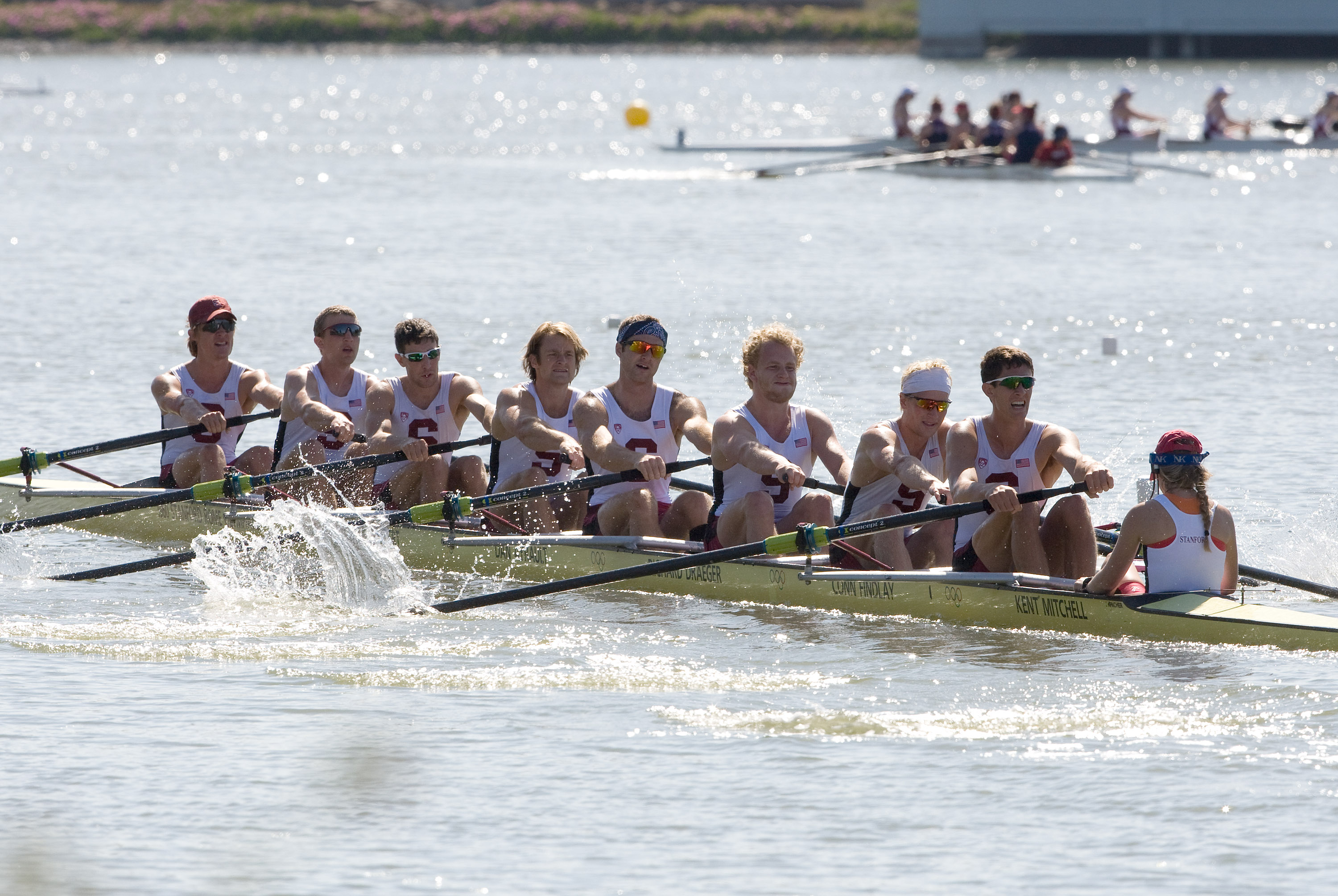
With this weekend’s forecast at the 111th Intercollegiate Rowing Association Championships (collegiate rowing’s national title) calling for temperatures nearing 100 degrees, it’s only fitting that Stanford’s Varsity Eight is getting hot at exactly the right time.
Two consecutive impressive performances on the water has the Cardinal right in the thick of things, ranked No. 4 and poised to go stroke for stroke with the top 22 teams in the country starting Friday at Lake Natoma in Sacramento.
“Stanford hasn’t been this highly ranked going into the regatta since 2005,” senior captain Oivind Lorentzen said. “We have our own heat that we are favored to win and we’ve just come into this with a lot of confidence.”
Turning the tables on California will do that for a boat, as the Card knocked off its rival Golden Bears and won the Schwabacher Cup earlier this month for the first time in five years. It was at the Pac-12 Championships, however, when Stanford really began to believe, hanging with No. 1 Washington for part of the race and roaring past Cal in the final 500 meters to grab the silver medal and a boatload of swagger.
“Beating Cal again at Pac-12s proved that [the first victory] wasn’t a fluke and it gave us an edge and the confidence we need to put us in a very good position,” Lorentzen said.
Competition at the IRA Regatta consists of heats (all composed of five or six boats), repechage (second chance races), semifinals and finals. In the varsity eight heats, the two fastest crews advance to the semis, while the rest are relegated to the repechage race, where the top three boats will gain entry back into the semifinals. In the semis, the top three crews advance to the six-boat Grand Final. The remaining crews will race in the Petite Final.
Included in the Stanford Varsity Eight’s first heat on Friday are No. 5 Northeastern, No. 13 Penn, No. 12 Wisconsin, No. 20 Holy Cross and No. 21 George Washington. The II Eight boat, seeded 13thoverall in the “B” class of the regatta, will compete against No. 12 Penn, No. 4 Princeton and No. 5 Harvard.
Because the racing calendar is filled mostly with regional regattas and competitions that don’t foster too much competition amongst the country’s heavyweights, this weekend is Stanford’s first good look at those boats as well as the rest of the class of the East Coast, which includes No. 2 Harvard and No. 3 Brown.
The Huskies, however, are clearly the class of the field, beating Stanford’s Varsity Eight by 5.4 seconds at the Pac-12 Championships as well as earning victories over Brown, Cornell and Dartmouth en route to an undefeated regular season for the sixth time in the last seven years.
“Washington certainly has a mystique to it,” Lorentzen said, “and they are the top team in the country. But we are going to go out and try to beat them. They’re not unbeatable, and if we can get to that position in the Grand Final first, then we’ll let all cannons fire. If you shoot for Washington and come up short, you’ll likely be second overall.”
Harvard, too, figures to be right up there with the rest of the big boys, having proved itself as the class of the East with a win at the Eastern Sprints and a tradition of placing well at IRAs (the Crimson has medaled in three straight years). Brown is no slouch either, finishing second at IRAs last season and securing the No. 3 seed thanks to a runner-up finish behind Harvard at the Eastern Sprints earlier this month.
All three schools ranked ahead of the Cardinal are sending a virtual armada of boats to IRAs, with, in some cases, five different boats qualifying for different classes at the competition. With a long legacy of excellence in the sport, these programs boast Olympic pedigrees up and down the oar ports, not to mention height and power. The Huskies have 13 rowers listed as 6-foot-5 or taller on their roster; Harvard and Brown both have many more.
Stanford, on the other hand, prides itself on being a group of somewhat undersized rowers that can thrive in the underdog position, according to Lorentzen, in addition to having possibly the best collegiate rower in the country, junior Austin Hack.
“Everyone [besides the 6-foot-8 Hack] is kind of relatively small,” he said. “But we’re all fit and we pride ourselves on being a tight-knit group of guys in the boat. Unlike a lot of teams, we’ve been rowing the same lineup since the beginning of the season and, while other guys on teams like Cal might have better erg scores, it just shows that ergs don’t translate well to races. It might be a surprise to a lot of people that we are so fast, but it’s not a surprise to us.”
Like most of the top teams, Stanford’s crew has been training for the race all week on Lake Natoma, a bit of a home water advantage. Lake Natoma is a 2,000-meter course 15 miles northeast of Sacramento, widely considered one of the best venues in the United States for intercollegiate rowing as the annual host of the Pac-12 Championships.
Despite the added pressure of completing homework and assignments from off-campus—a slight disadvantage considering the majority of the other schools have closed their academic years—Lorenzten said that being able to spend the week training on familiar water is already paying dividends for the Cardinal.
“Most teams come out to train pretty early, and usually the IRAs are on the East Coast; the competition rotates annually but was last on the West Coast in 2009,” Lorentzen said. “But for us not to have to deal with a time change and acclimate faster is good. It’s been very nice to get away from school and the distractions and concentrate on rowing for a week, and with really good water to practice on we’ve been getting significantly faster, even in just the last few days. We’re a lighter, fitter crew, and who knows, maybe the East Coast teams are not used to this dry heat.”
Stanford will find out how high it can set the bar when the starting gun goes off for the first heat at 8:45 a.m. Friday morning. The events will be streamed live in their entirety, with video feeds available at http://d3cast.com/rowing/ira.htm.
Contact Miles Bennett-Smith at [email protected]
